There are many ornamental and influential species to choose from when looking at the best plants that grow in water. Water-grown plants offer many advantages to homeowners who are looking at sprucing up their house plant collections and it is a very easy and decorative way to showcase your greenery indoors.
Many houseplants are inherently able to form new roots from plant pieces exposed to moisture so it’s a wonderful propagation adaptation that allows growers to expand on their collections with little to no expense.
In this guide, we’ll recommend our top picks for the best indoor plants that grow in water as well as include a few helpful tips to make the process fruitful for you.
More...
Guide to Plants that Grow in Water

Plants can be grown in many types of vases, jars and glasses, giving you more freedom to explore your home’s décor and houseplant displays. Growing plants in water is a very accessible and reliable method of establishing healthy houseplants which also makes it perfect for novice growers, kids or slightly neglectful enthusiasts.
It is important to know the ins and outs of water propagation, especially if the plant will be living in water indefinitely but it doesn’t require expert skills or complex hydroponic setups to get right.
Advantages of Growing Plants in Water
- Less Maintenance – It can be difficult to stay on top of the garden and houseplants simultaneously, especially if you travel a lot. If you also tend to overwater or underwater from time to time, this method will give you a complete low-care solution.
Plants grown hydroponically tend to use up to 90% less water than plants grown in soil so it’s also a fantastic water-conscious option. - Far Less Messy – You can completely avoid the mess and stress of dealing with soil. Soil scatter can become frustrating, especially if you have a cat that likes to sometimes dig through your pots. Growing in water will mean you won’t have to clean up any more soil.
- Fewer Pests and Diseases – Without soil, plants are far less susceptible to pests and diseases. Fungus gnats and mites can be a pain so by eliminating their reproductive medium, you can avoid having to deal with any such issues.
- Easily Expand on Your Collection – Though growth can be a little slower than soil, water is a super simple and effective way to propagate indoor plants and there are many beautiful varieties to choose from, meaning you can quickly expand on your collection to boost the natural spectacle of your indoor spaces.
- Creative Displays – From dainty to more elaborate displays, there are many exciting ways to showcase plants in vases, jars, glasses or other water-tight containers. This gives you a lot of freedom to create something unique and impactful in your home.
- Cuttings Love Water – Whether you intend on growing your plants exclusively in water or you’re just interested in a great way to propagate cuttings for your garden, knowing how to establish and grow plants in water is a very useful gardening skill.
How to Establish Plants that Grow in Water
The process can be as simple as placing cuttings into any container that can hold water, giving you a lot to work with. It is good to note that you can’t use containers made from copper, brass or lead as these metals can corrode when exposed to fertilisers which will cause plant damage so glass tends to be the best option in most cases.
Darker and more opaque containers can help to prevent algae from forming but clear containers allow the whole plant to be visible, roots and all, which can also look fantastic. Ultimately, it’s your preference depending on your needs and aesthetic desires.

Preparing Your Containers
It is always best to match the size of your containers with the size of the plants. Smaller cuttings only need a small space to thrive but as the plants grow, they will need to be moved into larger containers for continued stimulation.
Vases, jars, glasses, test tubes and wall-mounted vessels can all look fantastic.
Here are a few tips to help you prepare your growing containers:
- You can partly fill your containers with many different decorative and practical materials such as florist’s foam, gravel, pebbles, pearl chips, sand, marbles or beads. Anything that can add a little extra spark to your displays is always a good idea.
- It is considered best practice to add a small amount of powdered charcoal or a small piece of charcoal to the water to help keep it clean and smelling good. This will also help in reducing algae.
- For the actual mix of water, add a quality water-soluble fertiliser into the container at a quarter of the recommended dosage. This can help to boost the initial production of roots and growth. Feed annually during your plant's growing season.
Steps for Growing Plants in Water
It is often best to establish plants from cuttings when growing in water. However, small rooted plants can be used as well.
- Take Your Cutting – For cuttings, take a piece or stem of the plant you intend to duplicate using a sharpened and sterilised tool. Most plants require cuttings to have several leaves and nodes still attached.
Place the base of the cutting in your container filled with the water and fertiliser mixture. As the new roots grow, so will the foliage. Plants may need to be snipped in different ways depending on their species but most require a piece of vine, offsets or small sections of leaves to develop. - Rooted Plants – For more established rooted plants, be sure to wash the soil off the roots and cut away any damaged or dead leaves and stems before planting into the water.
- Position Your Plant – Now that you’ve rooted your plant in water, you can consider its position. New cuttings don’t enjoy harsh, full light as this can scorch them and warm the water up to uncomfortable temperatures. Be sure to also avoid drafts, cold temperatures and heat sources like fireplaces or radiators.
- Stay Patient – Plants that grow in water tend to grow far slower than plants established in soil. New growth can take some time in water depending on which plant you’re working with. Be sure to stay patient and you’ll have thriving houseplants in no time.
- Once roots are at least 1 inch long, plants can be moved into potting soil for growth in pots if that’s what you prefer. Alternatively, move your water-grown plants into larger water containers when you can see the roots becoming overcrowded and growth slows.
Ideal Growing Conditions for Plants That Grow in Water
Indoor plants that grow in water still require certain growing conditions to thrive and flourish best. Getting this right will ensure you have a very low-maintenance and attractive plant on display.
Remember that every plant has its own needs so if you’re unsure, be sure to look up what your plant specifically needs to thrive.
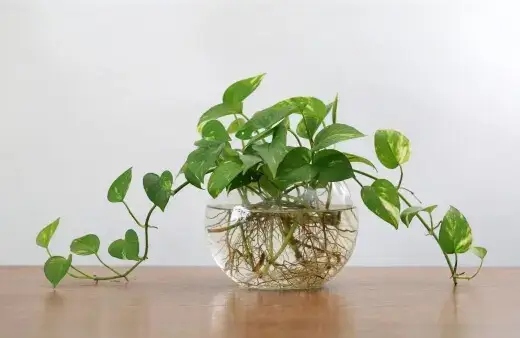
Lighting
Light is still essential for photosynthesis in water-grown plants so providing them with the right amount of light is vital to success. Each variety or species of plant will naturally require different lighting to thrive so it’s best to always check what your specific plant requires.


Get Your Free Guide:
Master Growing Australian Natives eBook
A Must Have Complete Guide for Every Australian Garden
Get Your Free Guide:
Master Growing Australian Natives eBook
A Must Have Complete Guide for Every Australian Garden
Generally, positions that offer bright but indirect light are great. The location should be warm but not hot.
Best Water for Hydroponic Plants
If your tap water is of high quality, that can work great. Allow tap water to sit for 24 hours before planting to reduce the possible chlorine content and allow the water to reach room temperature.
If you’re worried about your tap water being filled with too many harmful chemicals, bottled or rainwater makes for excellent substitutes. Also, be sure not to use water that has been heavily filtered as this will mean too many nutrients have been removed. Unchlorinated water tends to be best for plants.
Water Changes
Most plants will only need a monthly change of water but it also depends on the type of container you’re using, the plant and the lighting conditions. The water will naturally evaporate over time so fill weekly as needed and completely change the water out when it starts to look murky and smells funny.
Fertilising Needs
For new cuttings trying to grow roots, it is best to hold off on the fertiliser until roots have developed. As the plants grow, they will eventually need some fertiliser. Plants grown in water tend to respond best to lower-strength fertilisers so using a quality water-soluble fertiliser diluted to a quarter strength should work well for most plants.
Add fertiliser as needed when changing the water. Be sure to avoid over fertilising as this can also cause unwanted issues.
Algae Growth
Algae growth is natural. But if you’re noticing accelerated growth, this can mean that your plant is getting too much light or you’re overfertilizing. To treat algae, you can manually clean the container out when changing water, which can be difficult with smaller containers.
Another very effective strategy is to cover the container for a week to eliminate the light, thus starving the algae. This should quickly reduce the algae content. Remember to add some powdered charcoal or small pieces of charcoal to your water as this is also a great way to deal with algae.
30 Indoor Plants That Grow in Water
1. Herbs

Any herb that has a soft stem will be able to survive solely in water. When clipping herbs, be sure to cut from the soft, green stem and not the harder woody stems. Take your herb cutting from a mature and healthy plant. Water-grown herbs do best in a sunny spot with plenty of bright, indirect light.
For more on growing herbs, see our guide: How to Grow Herbs Indoors
2. Philodendron

Many philodendron species grow excellently in water. Heart-leaf philodendrons tend to do best. Take a 6-inch-long cutting and place it in a clear jar or container in a position that gets bright, indirect light. Change the water weekly and you should have a thriving philodendron.
3. Pothos
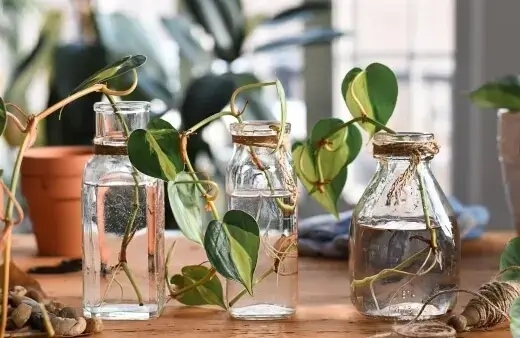
Sporting glossy heart-shaped leaves with gorgeous variegation in many cases, pothos makes for an excellent ornamental option. Clear fish bowls can work well for these plants when growing in water. They also work well for elevated positions, allowing the foliage to cascade and drape in your spaces.
4. Spider Plant

The narrow and arching foliage looks fantastic in tall, slender glass containers. These plants may require a water change every 2 to 3 days. Find out how to grow and care for spider plant here.
5. Coleus
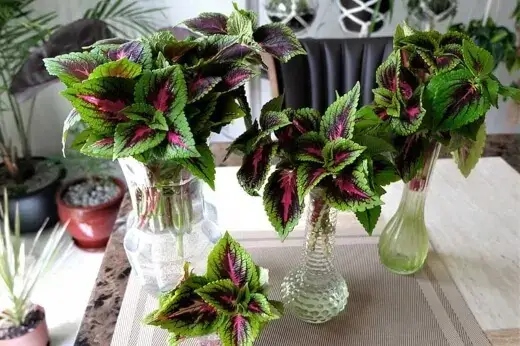
An excellent colourful addition that boasts wonderfully serrated leaves, this plant can grow very well in water and only requires indirect light to thrive. Perfect for tabletops and centrepieces.
Don't miss our Coleus growing guide and find out which varieties grows best in Australia.
6. Dracaena

Most of the indoor dracaena varieties adjust well to being grown in water. With their narrow forms and upright foliage, they tend to look best in glass jugs and narrow jars.
7. Croton

Croton is one of the most striking indoor plants that grow in water. The colourful, variegated leaves look stunning atop clear containers. Unfortunately, these plants can’t grow in water permanently but cuttings can survive for some time and add some exotic touches inside.
8. Begonia
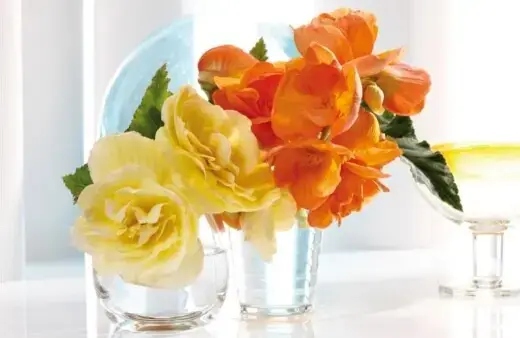
The spotty, wavy leaves of this plant look great atop clear jars. They might start to fade eventually but you can simply establish them continuously using new cuttings as needed.
9. English Ivy
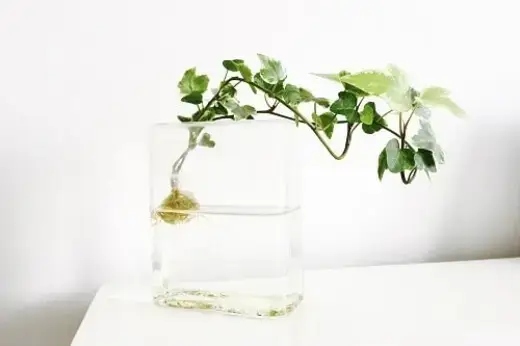
A perfect pick for growing in water, this attractive plant features lush green, shapely leaves that look beautiful extending from water-filled containers. These plants can grow in water for a long time.
10. Caladium

With broad, elephant-shaped leaves that glow in reddish-pink hues with green edges, caladiums are a good pick for more colour. They look great on dining tables, desks or table tops as centrepieces. Get to know more caladiums here.
11. Moth Orchid
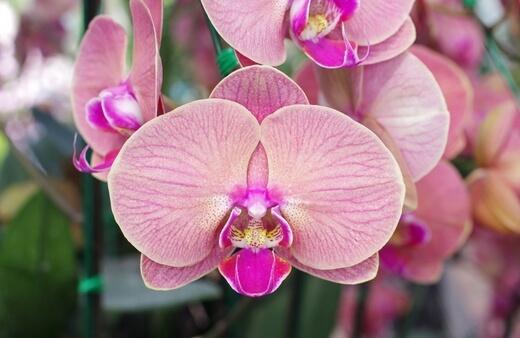
The dainty, delicate pink and white flowers along with the plant's tropically smooth foliage look brilliant in containers filled with water. The root system can also add a decorative touch to any jar or glass. Be sure to support the roots using some colourful pebbles or sand.
Check out our comprehensive guide to growing moth orchid and discover the best varieties to grow in Australia.
12. Prayer Plant
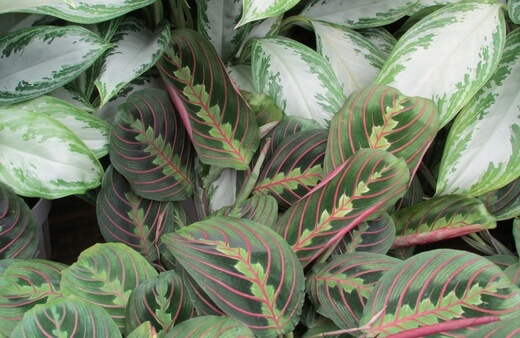
One of the most accessible plants that grow in water, the prayer plant adds an adorable and ornamental touch to indoor spaces when planted in water from cuttings. The dark-green leaves with red striations look great in glass jars.
13. Chinese Money Plant
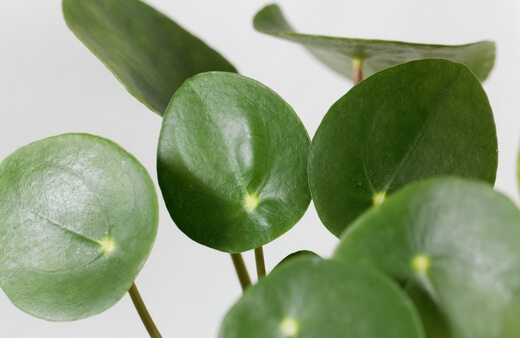
An adorable option for water growing. The dainty round leaves and attractive root system will always look fantastic in clear jars or vases. This plant will need plenty of bright light to thrive.
14. Monstera

A notoriously excellent houseplant that does well in water if cared for properly, monstera will easily impress with its sizable serrated foliage. Here are more details on how to propagate Monstera in water, soil, and also in the air.
15. Mint
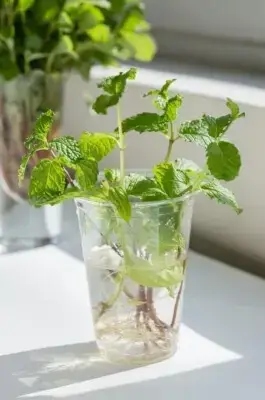
A great choice if you want a regular supply of mint in the kitchen, this plant does very well in water. You can also use the leaves as a room freshener by crushing a few.
16. Aluminum Plant
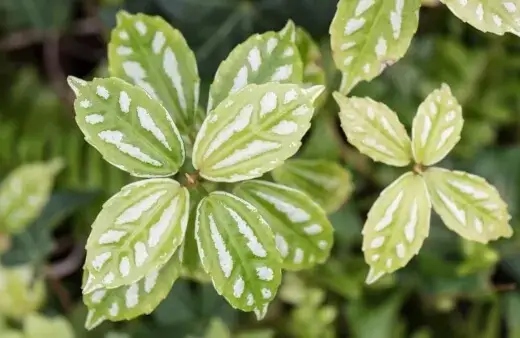
With variegated grey to green foliage with delicate stems, this plant looks its best in clear glass containers filled with clean water. Medium to low light positions are recommended for this houseplant.
17. Sweetheart Hoya
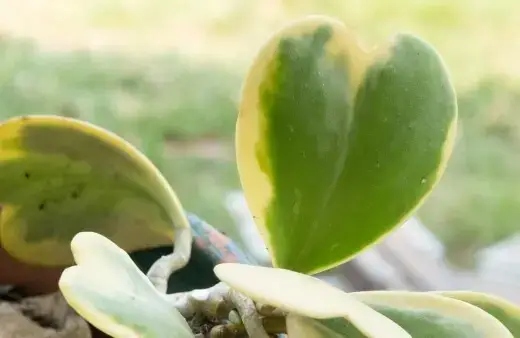
A great tropical addition, this plant grows brilliantly in water with its thick stem. Taller glasses tend to work best and an area that gets bright, indirect light is ideal.
Get to know more about Hoya growing guide to find out the best varieties to grow here in Australia.
18. Ti Plant

An exotic-looking plant that boats slender stems with lush relaxed foliage, this plant is best propagated in water using a 5 to 8-inch long cutting taken from a mature and healthy parent plant. Remove the lower leaves and place the cutting in a vase of clean water.
19. Alocasia

With similar leaves to that of monstera but smoother and less serrated, this plant responds well to being grown in water. It also features stems with a zebra-like pattern so it’s an all-around stunner.
It is best propagated by dividing clumps of offsets with a clean and sharp knife. Check out our guide on how to grow Alocasia and its varieties for more info.
20. Paperwhite Plant
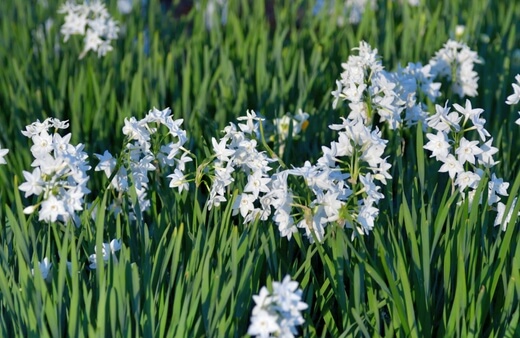
This plant is one of the most decorative options when looking at indoor plants that grow in water. With tall, slender lime-green stems that form upright and delicate white blooms atop it all, paperwhite bulbs grow well in water.
The bulbous roots will need some support from gravel, seashells or other supporting materials. Keep in a bright location.
21. Impatiens
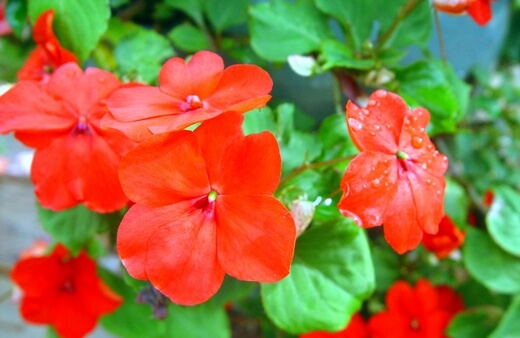
Another gorgeous flowering option, Impatiens can grow in water for a long time. It features dark-green broad leaves with blushing-pink flowers.
22. Wandering Jew
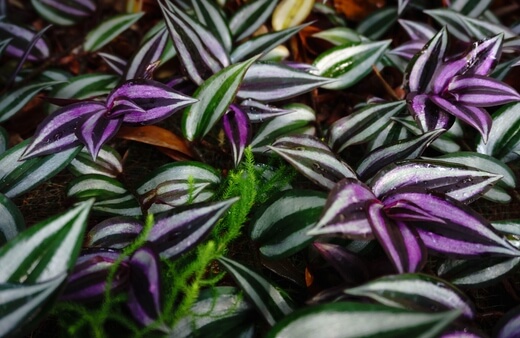
These plants are as tough as they are ornamental. They thrive in warm climates, featuring pink, purple and green striped leaves and an attractive root system. This plant looks its best in taller clear containers, allowing its full form to decorate your spaces.
23. Arrowhead Plant
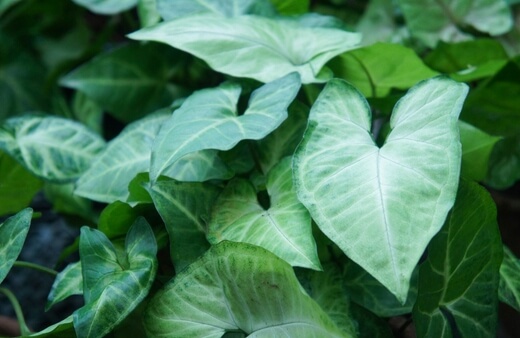
The arrowhead plant is another great option if you enjoy large leaves. This tropical plant also has thick roots that respond well to growing in water. It is a climbing and vining plant, making it a great addition as a spreading feature specimen.
24. Lucky Bamboo
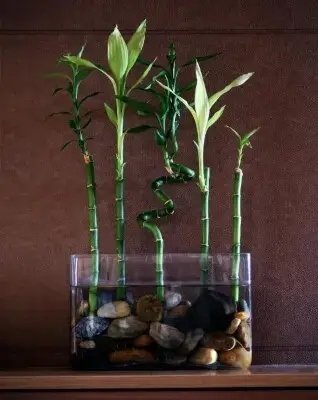
Famed for its forgiving nature and unapparelled ornamental tropical form, lucky bamboo is one of the more stylish options when looking at plants that grow in water. It suits water-growing perfectly and looks best in narrow, clear containers.
The roots must be fully submerged in water and adding some gravel around them will help stabilise the plant.
25. African Violet

These fluffy plants feature cute round leaves with tiny hairs on them and colourful flower colours. They grow best in water from leaves and they root in about a month. You can also grow this plant on soil which we laid out in our complete African violet growing guide.
26. Spiderwort

An excellent choice if you want more colour indoors, this plant features arching burgundy foliage and thin white roots. It works great as a feature plant in any room and clear containers will allow the plant's full effect to impact your spaces.
27. Chinese Evergreen

The variegated and leathery leaves produce striking silvery patterns, making this plant a highly decorative choice. They also grow well in water and look fantastic in larger clear containers filled with small rocks and shells.
28. Dumb Cane

Featuring large variegated leaves and an easy-going nature, this plant is perfect for growing in water. 6-inch cuttings should be used to establish your plant in water. Keep it in bright light out of the direct sun and be sure to handle this plant with gloves as the sap can cause skin irritation.
29. Rubber Fig Plant
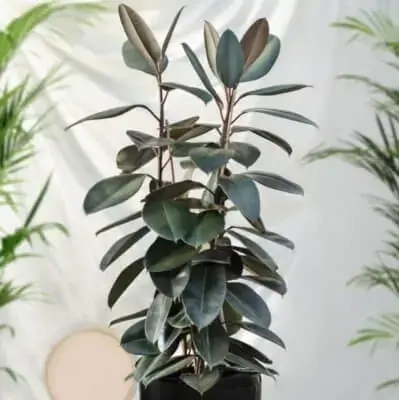
With large waxy green leaves, often variegated, this plant also features an upright growing habit that looks fantastic atop slender containers. They can be slow-growing in water but the wait is well worth it.
If you decide to grow this plant on soil then refer to our Ficus elastica growing guide for everything you need to know.
30. Devil’s Ivy

Commonly known as golden pothos, this plant is a widely cultivated vining plant with delicate heart-shaped leaves variegated in green and yellow. Another great option for those who want to add a cascading or draping effect to their spaces.
Taller containers or wall-mounted vessels make this plant look its best in water. Get to know more about this plant by reading our Devil's Ivy growing guide.
Can't get enough of indoor plants? Be sure to check our compilation of mixed indoor plants to grow in Australia.
Plants That Grow in Water Frequently Asked Questions
Can you grow plants in water permanently?
Many common houseplants can thrive in water indefinitely as long as you provide them with the conditions needed to grow their best. Hydroponic growing can truly add a new layer to how you showcase your indoor plant collections.
What are the negative effects of hydroponics?
Waterborne diseases can become more likely for plants grown exclusively in water. Be sure to regularly change the water out as needed to keep your containers clean and free of disease.
What veggies can be grown in just water?
Garlic, sweet potato, lettuce, peppers, carrots and even pineapples can be grown in water exclusively.
Elevate Your Home with Our Exquisite Selection of Plants That Grow in Water
Regardless of which plants to choose to establish in your home's water garden, you can be assured that presenting your houseplants this way is an excellent method for both functional and ornamental applications.
There are endless possibilities for you to elevate your indoor spaces using these fantastic indoor plants that grow in water. Whether you’re looking for something simple, something grandiose or something to add lush aesthetics to your home, you’re bound to find the right pick for your needs with our best plants that grow in water.
Published on January 17, 2023 by Maisie Blevins
Last Updated on September 20, 2025




